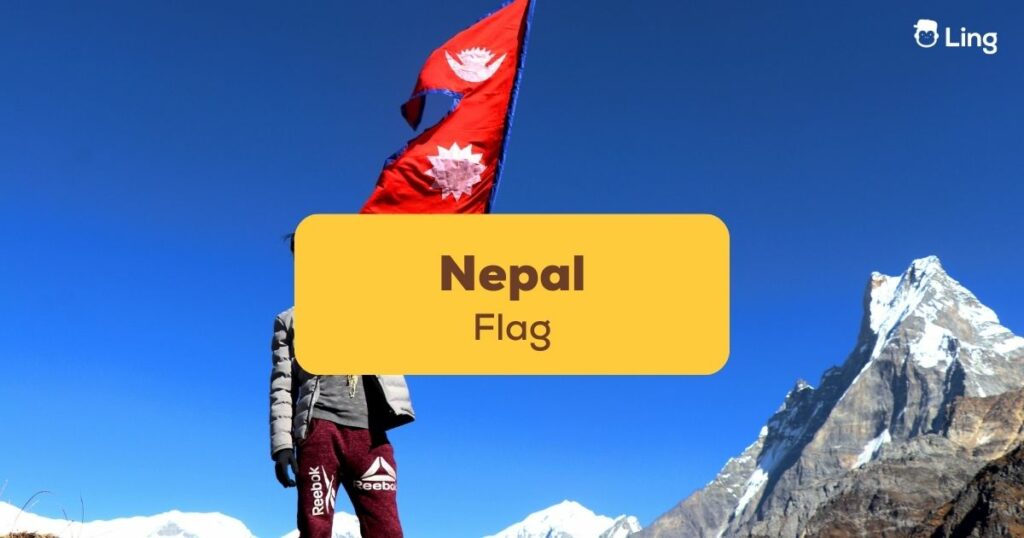Among the seemingly endless collection of flags that fly on the international stage, there is one that stands out because of its distinctive shape – the Nepal flag. A true embodiment of the country’s history and national pride, the Nepalese flag is a testament to the country’s enduring spirit.
So, this time, let’s look at what makes Nepal’s national flag – the only non-quadrilateral national flag in the world – so special.
History Of The Nepal Flag: Unraveling The Origins
Nepal, a country locked between the borders of neighboring India and China, boasts a tumultuous history that spans thousands of years.
The origins of the Nepalese flag can be traced back to the 18th century during the rule of the Shah dynasty. King Prithvi Narayan Shah, the founder of modern Nepal, introduced the banner that would come to symbolize the nation. The flag was initially a combination of two triangular shapes – a fusion of blue and red, representing the mountains and bravery of the Nepalese people, respectively. Triangular-shaped flags were common across much of South Asia because their compact size meant when unfurled they would fly in even the slightest breeze.

A Masterpiece Of Geometry: Unique Flag Design
What truly sets the flag of Nepal apart is its shape. Unlike the rectangular flags that are commonplace around the world, the Nepalese flag is composed of two stacked triangles. The top triangle is significantly smaller and points towards the flagpole, while the larger triangle forms the rest of the flag.
The larger triangle is a crimson-red color, signifying the bravery of the Nepalese people. The crimson-red color is also significant as it is the shade of the country’s national flower – the Rhododendron. It symbolizes their willingness to shed blood to protect their sovereignty and independence. The upper triangle represents the towering Himalayan mountains that watch over Nepal.
Sun And Moon: The Flag Elements
Centrally situated on the crimson background of the flag are two symbols – a white crescent moon and a white-stylized sun, edged with a dark blue border.
Both the sun and the moon are depicted side by side, imparting a sense of balance and equilibrium. Both once had human faces until they were removed in 1962.
The crescent moon, symbolizing the many Nepalese dynasties, casts its gentle glow over the nation and symbolizes the cool weather of the Himalayas. It’s also representative of the peaceful and calm nature of the Nepalese people. The sun symbolizes, with its powerful rays extending outward, the fierce determination and bravery of the population. Together, these elements create a harmonious interplay of light and dark, softness and strength.

Evolution Of The Flag: A Symbol Of Progress
The Nepalese flag has not remained static over the centuries. It has evolved alongside the nation’s journey through history. In the middle of the last century, the Shah dynasty was replaced by a democratic government, marking a significant shift in the political landscape of Nepal.
With this change came the need for an updated version of the flag. The celestial bodies, the moon, and the sun, were relocated to the flag’s upper edge. This alteration was emblematic of Nepal’s new direction – a nation guided by the principles of democracy, equality, and progress. The Nepalese constitution adopted the current flag of Nepal on December 16, 1962. It is an amalgam of the flags of the former Mustang Kingdom and the former Gorkha Kingdom.
Flag Etiquette And Usage
Flags hold a special place in the hearts of citizens, and as such, proper flag etiquette is essential. In Nepal, the flag must never touch the ground or be used for trivial purposes. It is raised every morning and lowered every evening as a mark of respect. The flag is also prominently displayed during national holidays, events, and diplomatic occasions.
Words Related To The Nepal Flag
| English | Nepali (Devanagari) | Transliteration |
|---|---|---|
| National Flag | राष्ट्रिय झण्डा | Rāṣṭriya Jhaṇḍā |
| Flag | झण्डा | Jhaṇḍā |
| Blue | नीलो | Nīlo |
| Red | रातो | Rāto |
| Sun | सूर्य | Sūrya |
| Moon | चन्द्र | Candra |
| Crescent | अर्धचन्द्र | Ardha-Candra |
| Symbol | प्रतीक | Pratīk |
| Unity | एकता | Ekatā |
| Sovereignty | राजत्व | Rājatva |
| Dignity | मर्यादा | Maryādā |
| Peace | शान्ति | Śānti |
| Harmony | सामन्जस्य | Sāmanjasya |
| Hope | आशा | Āśā |
| Progress | प्रगति | Pragati |
Guardian Of National Identity: The Flag’s Cultural Significance
For the Nepalese people, the flag is not merely a piece of cloth to be run up and down a flagpole – it is a representation of their heritage and their pride. The eight rays of the white moon and twelve rays of the white sun express a hope that the country will continue to exist in this world for the same longevity as the sun and the moon that watch over it.
The flag is an integral part of national celebrations and events. It flies high during festivals, marking momentous occasions like Constitution Day and Democracy Day.
The flag of Nepal is far more than a uniquely decorated piece of cloth; it is a living emblem of a nation’s history, identity, and aspirations. Its unmistakable shape and striking color combination tell a story of unity, bravery, and the harmonious coexistence of diverse cultures.
It stands as a testament to Nepal’s unbroken sovereignty and its enduring commitment to peace and progress. As the crimson and blue flutter in the Himalayan winds, the Nepali flag continues to be a source of pride and inspiration for its people and a symbol recognized across the globe.
Learn More About Nepal With Ling
Nepal is a truly unique country in so many ways and the perfect way to experience the country before you go is through the Ling app. Ling will not only get you up to speed with the Nepali language but has tons of blogs that will teach you about the country, the people, and their culture. Download the Ling app from App Store or Google Play and begin your Nepali adventure today.

































































